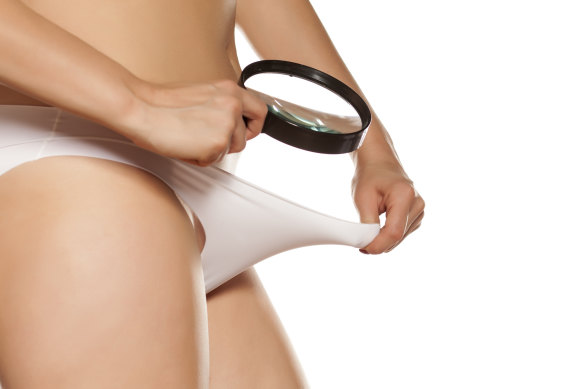[ad_1]
Back when Kings Cross was still a red-light district, the real-life porn hub of the global city of Sydney, I was at a party in one of the luxury apartments rented by cool, hip young things who wanted to be close to the action. Out on the balcony smoking, as one did in those days to meet the most interesting people, was where I met my friend the pornographer. Within seconds we’d said “see you next Tuesday” – and that was before we’d even agreed to catch up again.
It was on that night that I first heard, from the pornographer, about what the government was doing to women’s vaginas. The outrage came rushing back to me when Women’s Health Victoria recently released a report which finds that women are increasingly seeking cosmetic labiaplasty – a procedure that removes some of the labia (the inner and outer lips of the vagina) – because they believe theirs are ugly, unusual or “disgusting”.

Nearly a quarter of Gen Z women are anxious, ashamed or embarrassed by how their labia look.Credit: Getty Images
Nearly a quarter of Gen Z women (those surveyed for this study were aged 18 to 24) are anxious, ashamed or embarrassed by how their labia look, according to the report. And almost a third of them associate their labia with negative words. One in five were obtaining their information on what labia “should look like” from porn and 30 per cent from social media.
Which recalled something the pornographer told me that left me incensed (and cemented our friendship forever): women’s vaginas all look very different but they were not allowed to reflect that in their porn.
The government censor had required that People Magazinewhere he worked, and its competitors available on news stands, photo-edit vaginas to remove visible labia. The term in the industry was “healing to a single crease”. He and his team didn’t want to do it – they found the practice as offensive as I hope you do. As he put it when I called him to chat for this column, the team at People (which included many women who weren’t in front of the camera) knew they could be considered sexist “but we loved women, we were never misogynist”.
Loading
It killed them that they were required to treat women as imperfect. But one issue a year had to be submitted to the government censor, chosen by the censor at random, and if the vagina in that issue was not “healed” the entire issue could be pulled from sale. So the industry applied a heightened standard of editing to all issues.
This is how beauty standards are set. Fashion magazines airbrush away bumps, curves, dents and kilos. Pornography mutilates women’s genitalia by scrubbing away pixels with Photoshop’s Magic Eraser. And the next thing you know, this is how men and women start expecting bodies and vaginas to look, driving the demand for surgery.
Of course, it’s nothing new. There is the tale of the 19th century writer, art critic and polymath John Ruskin. Ruskin was a devotee of the pre-Raphaelite school of painting, in which female nudes had marvellous hair cascading from their heads and no muff on their tucked stuff. When Ruskin married the beautiful Euphemia Gray, he left the marriage unconsummated because, as she wrote to her father, he “had imagined women were quite different to what he saw I was” and so “did not make me his Wife because he was disgusted with my person the first evening”. This has led to the popular theory that, as one scholar has written, “John, familiar only with the smooth (marble) vulvas of classical art, was shocked and repulsed by the sight of pubic hair on his bride and could not desire his new wife”.
[ad_2]
Source link